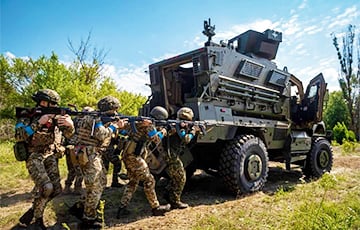NYT: Russia Could Change Trajectory Of Ukraine War
12- 15.05.2024, 12:08
- 10,162

The US is expecting “critical” months at the front.
US President Joe Biden's administration is concerned that the current momentum Russia has achieved on the battlefield in Ukraine is “changing the trajectory of the war.”
The American newspaper New York Times writes about this, citing a number of sources in official circles of the United States and allied countries.
The publication recalls that although a year and a half ago the White House and the Pentagon were discussing whether there would be a complete collapse of Russian troops in Ukraine, now the Biden administration “is increasingly concerned that Vladimir V. Putin is gathering enough momentum to change the trajectory of the war”, and perhaps reverse his “once-bleak” prospects.
In private, some of President Biden’s aides worry that just as the United States has learned key lessons from the war — about technologies that work and those that do not — so has Putin.
And their biggest concern is that as Russia replaces weaponry wiped out in the first 27 months of the war, Mr. Putin may be regaining ground just as Mr. Biden prepares to meet his closest allies at a Group of 7 meeting in Italy next month. It is unclear whether Mr. Biden will be able to repeat the claim he made in Finland last summer, that Putin “has already lost that war”, NYT writes.
At the same time, officials — NYT sources — claim that Joe Biden continues to reject the proposal to deploy Western troops in Ukraine, which is supported by French President Emmanuel Macron.
The publication cites the opinion of a number of analysts, including Stephen J. Hadley, the national security adviser under President George W. Bush, and states that a number of factors contributed to Russia’s current momentum:
The delay in U.S. funding, Russia has been able to achieve a “huge artillery advantage” over Ukraine;
The lack of air defense ammunition has also allowed Russia to use its air power with more impunity, attacking Ukrainian lines with glide bombs;
The delay by Ukraine in approving a mobilization law to bring more, and younger, soldiers into its military. Ukraine is suffering acute shortages of soldiers, and is struggling to provide adequate training to those it brings into the military;
Russian technological innovations on the battlefield, in particular the increase in the presence and power of electronic warfare (EW), which interfere with, among other things, artillery and drones provided by the United States and other NATO countries.
“These battlefield advantages are ephemeral, of course, and the war may look as different 18 months from now as it does from 18 months ago. But there is a growing sense inside the Biden administration that the next few months could prove critical, because at some moment the two sides may finally move to a negotiated cease-fire, an armistice similar to the one that ended the active fighting in Korea in 1953 — or simply a frozen conflict”, NYT writes.
But all those Russian advantages will not last indefinitely, and Russian forces are likely to make a push this summer, said Michael Kofman, a Russia expert at the Carnegie Endowment for International Peace in Washington.
“In 2024, the Russian military enjoys a material advantage, and the strategic initiative, though it may not prove decisive,” Mr. Kofman said. “This year represents a window of opportunity for Russia. But if the Russian military is not able to turn these advantages into battlefield gains and generate momentum, there’s a fair chance that this window will begin to close as we enter 2025.”
NYT states that today this “new momentum” of Russia is mostly evident in the Kharkiv region, where Russia is trying to create a buffer zone that Putin has said will make cross-border attacks harder for Ukraine to carry out. Recently, the head of Ukraine’s military intelligence agency has called the Russian advance near Kharkiv “critical”. Some outside experts caution that Russia’s real strategic aim in taking territory around Kharkiv is to force Ukraine’s troops to move to reinforce the city, weakening the front lines elsewhere. That could set up an opportunity for another Russian drive in June, in the Donbas, the part of eastern Ukraine that the Kremlin has illegally annexed and is trying to capture, stated in the material.
“The Russian offensive aim is likely to draw Ukrainian reserves and elite units, then pin them in Kharkiv, thereby weakening the rest of the front,” Mr. Kofman said. “The primary Russian objective still remains recapturing the rest of the Donbas.”
Whether they are able to do so may depend in part on how successful Ukraine’s mobilization efforts are, NYT reminds.
The United States is also trying to bolster technical advice to Kyiv, hoping to counter Russian technological advances. In some cases, Russia has successfully deceived GPS receivers, throwing off the targeting of Ukrainian arms, including a variety of missiles shot from HIMARS launchers, which Mr. Biden began providing to Ukraine last year.
“Those launchers are scarce, but the Russians have grown more successful in tracing their movements, and in some cases destroying them even when they are well camouflaged”, NYT sums up.










